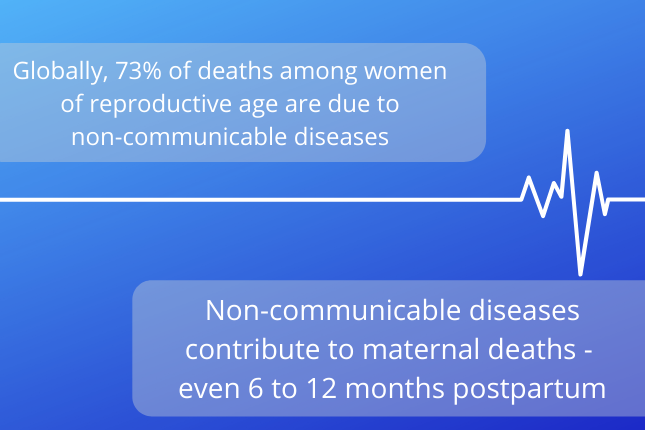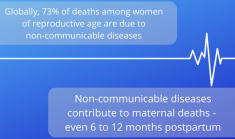-
CODE BLUE: The Importance of Integrating Care for Maternal Health and Non-Communicable Disease
December 5, 2019 By Deekshita Ramanarayanan
“Non-communicable diseases have been the leading cause of death for women for at least the past 30 years but are often underreported and undertreated,” said Priya Kanayson, Policy and Advocacy Manager at NCD Alliance at a recent Wilson Center event on the impact of non-communicable diseases (NCDs) on maternal health. The event marked the official launch of the Maternal Health Initiative’s CODE BLUE series, developed in partnership with EMD Serono, a business of Merck KGaA, Darmstadt, Germany. Globally, in 2018, 73 percent of deaths among women were due to NCDs, amounting to 18 million women of reproductive age dying per year due to NCDs. The compounding effects of NCDs complicate women’s experiences in many unseen ways, and the rise and gravity of NCDs pose a growing and often overlooked challenge to maternal health worldwide.

“Non-communicable diseases have been the leading cause of death for women for at least the past 30 years but are often underreported and undertreated,” said Priya Kanayson, Policy and Advocacy Manager at NCD Alliance at a recent Wilson Center event on the impact of non-communicable diseases (NCDs) on maternal health. The event marked the official launch of the Maternal Health Initiative’s CODE BLUE series, developed in partnership with EMD Serono, a business of Merck KGaA, Darmstadt, Germany. Globally, in 2018, 73 percent of deaths among women were due to NCDs, amounting to 18 million women of reproductive age dying per year due to NCDs. The compounding effects of NCDs complicate women’s experiences in many unseen ways, and the rise and gravity of NCDs pose a growing and often overlooked challenge to maternal health worldwide.
Maternal mortality has declined since 2000, but there is still a long way to go, said moderator Dr. Ana Langer, Director of the Women and Health Initiative and Professor of the Practice of Public Health at Harvard’s T.H. Chan School of Public Health. While the global number of maternal deaths has declined by 35 percent, the vast majority of deaths occur in sub-Saharan Africa and South Asia. The United States is the only high-income country experiencing an increase in maternal mortality, although many of the deaths could be averted. About every 12 hours, a woman dies due to complications resulting from pregnancy, and more than 60 percent of those are preventable, said Dr. Lisa Waddell, Senior Vice President of Maternal Child Health and NICU Innovation and Impact Deputy Medical Director at March of Dimes. While it is important to discuss how the causes of maternal mortality and morbidity are distributed, it is extremely difficult to collect and measure data on different causes. A major issue to address, Dr. Langer said, is the role of indirect causes, including NCDs, on maternal mortality and morbidity.
Multiple Medical Conditions
It is important to look at “pregnancy as a window” on future health, said Charlotte Warren, Director of the Ending Eclampsia Project and Maternal and Newborn Health Portfolio Lead at Population Council. A common thread identified across the main NCDs discussed—cardiovascular disease, diabetes, hypertension, chronic respiratory disease, multiple sclerosis, thyroid disease, mental health, and cancer—was the prevalence of comorbidities and multiple morbidities. Cardiovascular disease, a leading cause of maternal death in the United States, is associated with a cycle of gestational and Type II diabetes, another common NCD in pregnancy, and obesity, a common risk factor across all NCDs, said Dr. Wanda Nicholson, Director of the Diabetes and Obesity Core and Professor of Obstetrics and Gynecology at UNC-Chapel Hill and Immediate Past Fellow-at-Large with the American College of Obstetricians and Gynecologists (ACOG).
Obesity before pregnancy can lead to hypertension, obesity, and glucose intolerance during and after pregnancy. This increases the risk of cardiovascular disease and diabetes during and after pregnancy, across a woman’s lifespan. Hypertensive disorders in pregnancy, another leading cause of maternal and newborn death, is associated with long-term risk of cardiovascular disease, said Warren. Hypertension leads to over 70,000 maternal deaths and 500,000 newborn deaths globally each year. Pre-eclampsia, a common hypertensive disorder, is associated with a 3.7-fold increase in future cardiovascular disease and stroke.
Mental health disorders are common co-morbidities of other NCDs. Between 18 to 25 percent of women living in low- and middle-income countries experience depression, said Kanayson. One in three cancer patients in the United States experience mental or emotional stress, according to the National Cancer Institute, and 40 percent specifically experience anxiety disorders. Studies show women are more likely to develop anxiety and depression in the first year after childbirth than any other time of life.
Integrated Solutions
“We know that a third of maternal deaths occur in the postpartum period,” Dr. Nicholson said. This postpartum period of six to twelve weeks is relatively short compared to the nine months of pregnancy. Successful and comprehensive programs and interventions to prevent maternal mortality and morbidity during and after pregnancy are needed. While programs to address NCDs within maternal health are becoming more common in the United States, few programs take this integrated approach globally.
One that does is Population Council’s Ending Eclampsia project, a program funded by the U.S. Agency for International Development (USAID) to expand access to proven, underutilized interventions, tools, and resources to prevent detect early, and treat pre-eclampsia and eclampsia. In addition to addressing hypertensive disorders for pregnant women, said Warren, Ending Eclampsia works with women’s groups in-country to improve health literacy around successful treatment and prevention for hypertensive disorders in pregnancy. In the United States, March of Dimes has seen success in programs like Supportive Pregnancy Care, a model for group prenatal care that has increased support for mothers through group prenatal care to reduce preterm birth.
NCD Alliance has worked to integrate NCDs and reproductive and maternal health, notably with the Healthy Caribbean Coalition, an organization dedicated to NCD prevention and control through civil society involvement. NCD Alliance implemented cervical cancer screenings in six countries and trained educators to talk about family planning as well as NCD risk factor education, says Kanayson.
Spotting Heart Disease
The American College of Obstetricians and Gynecologists has recently implemented several programs to address cardiovascular disease within maternal health, said Dr. Nicholson. The Alliance for Innovation on Maternal Health Program (AIM) is funded by the Department of Health and Human Services to prevent maternal mortality and morbidity by working within hospital facilities, professional groups, and national public health programs. The AIM program has also developed collaborations among perinatal care providers and promoted maternity safety bundles, a set of best practices specific to individual NCDs and other causes of maternal mortality and morbidity. These maternity safety bundles revolve around the “four R’s”: readiness, recognition, response, and reporting. Additionally, ACOG has recently partnered with the American Heart Association to release a call to action to develop best practices to recognize cardiovascular disease early and throughout each stage of pregnancy.
Breaking Down Care Silos
A pilot program Dr. Nicholson launched at UNC-Chapel Hill called “Healthy Transitions” seeks to create a new and innovative model of care to increase surveillance of new mothers and integrate interventions for dietary changes, physical activity, and postpartum depression with women’s primary care. Promoting interventions such as these from a broader lens is one step towards breaking down the silos between NCDs and maternal health in primary care settings.
It is also important that programs address misconceptions around less common NCDs, such as multiple sclerosis (MS). Research shows that while there is a decrease in MS relapses during pregnancy, the postpartum period is associated with an increase in the frequency and severity of relapses in women living with MS. EMD Serono’s upcoming Family Planning Resource Center seeks to address the misconceptions around MS and fertility and serve as a resource for women with MS who want to start a family, said Terrie Livingston, Head of Patient Outcomes & Solutions for Neurology and Immunology and Medical Affairs and Multiple Sclerosis Patient Advocate at EMD Serono. Shortly after the birth of her second son, Livingston herself began experiencing symptoms of MS that went undiagnosed for two years, such as fatigue, cognitive issues like loss of short-term memory, hearing loss, vertigo, and trouble breastfeeding. Often, providers do not see these symptoms as a sign of MS, as they are also common features in the postpartum period for women.
Because of multiple misconceptions, women living with MS face stigma and often are told they should not start a family. Despite this, women with MS are having children and in fact, pregnancy rates among women with MS are higher today than those for women without MS. “I think there is a big opportunity to provide education” to women living with MS and their providers around planning for a family, said Livingston.
Read More:
- Children born to mothers with NCDs are at a higher risk for negative health outcomes.
- Investing in women and children across all sectors can improve maternal health.
- More than 700 women die in the United States every year due to pregnancy-related causes.
Sources: National Multiple Sclerosis Society, World Health Organization.
 A Publication of the Stimson Center.
A Publication of the Stimson Center.





